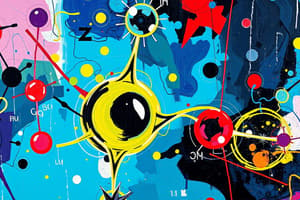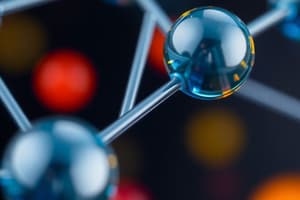Podcast
Questions and Answers
What determines the atomic number of an element?
What determines the atomic number of an element?
- The number of protons (correct)
- The average mass of isotopes
- The number of electrons
- The number of neutrons
Which type of bond involves the sharing of electrons between nonmetals?
Which type of bond involves the sharing of electrons between nonmetals?
- Ionic bond
- Hydrogen bond
- Covalent bond (correct)
- Metallic bond
What characterizes the particles in a solid state of matter?
What characterizes the particles in a solid state of matter?
- Particles have high kinetic energy and move randomly
- Particles are fixed in place and maintain a definite shape (correct)
- Particles are loosely packed and flow easily
- Particles move freely and are far apart
Which bond forms when one atom loses electrons and another gains electrons?
Which bond forms when one atom loses electrons and another gains electrons?
What is the average mass of all the isotopes of an element called?
What is the average mass of all the isotopes of an element called?
In which state of matter do particles have the highest kinetic energy?
In which state of matter do particles have the highest kinetic energy?
What type of bond is characterized by a sharing of delocalized electrons among metal atoms?
What type of bond is characterized by a sharing of delocalized electrons among metal atoms?
Chemical reactions involve what key process?
Chemical reactions involve what key process?
What are reactants in a chemical reaction?
What are reactants in a chemical reaction?
Which of the following types of reactions involves the combination of reactants to form a single product?
Which of the following types of reactions involves the combination of reactants to form a single product?
What is the significance of a pH value of 7?
What is the significance of a pH value of 7?
What does the term 'stoichiometry' specifically refer to in chemistry?
What does the term 'stoichiometry' specifically refer to in chemistry?
Which property is not considered a colligative property?
Which property is not considered a colligative property?
Which of the following statements about strong acids and strong bases is true?
Which of the following statements about strong acids and strong bases is true?
What does chemical equilibrium refer to?
What does chemical equilibrium refer to?
Which statement about the periodic table is correct?
Which statement about the periodic table is correct?
Flashcards
Atom
Atom
The smallest unit of an element that retains the chemical properties of that element. It is composed of protons, neutrons, and electrons.
Protons
Protons
Positively charged particles found in the nucleus of an atom.
Neutrons
Neutrons
Neutral particles found in the nucleus of an atom. They have no charge.
Electrons
Electrons
Signup and view all the flashcards
Chemical bond
Chemical bond
Signup and view all the flashcards
Ionic bond
Ionic bond
Signup and view all the flashcards
Covalent bond
Covalent bond
Signup and view all the flashcards
Solid
Solid
Signup and view all the flashcards
Reactants
Reactants
Signup and view all the flashcards
Products
Products
Signup and view all the flashcards
Chemical Equation
Chemical Equation
Signup and view all the flashcards
Reaction Rate
Reaction Rate
Signup and view all the flashcards
Chemical Equilibrium
Chemical Equilibrium
Signup and view all the flashcards
Thermodynamics
Thermodynamics
Signup and view all the flashcards
Periodic Table
Periodic Table
Signup and view all the flashcards
Groups in the Periodic Table
Groups in the Periodic Table
Signup and view all the flashcards
Study Notes
Atomic Structure
- Atoms are the fundamental building blocks of matter, composed of protons, neutrons, and electrons.
- Protons have a positive charge, neutrons are neutral, and electrons have a negative charge.
- Protons and neutrons reside in the nucleus, while electrons orbit the nucleus in various energy levels or shells.
- The number of protons in an atom determines its atomic number and defines the element.
- Atoms strive for a stable electron configuration, often achieved by gaining, losing, or sharing electrons with other atoms.
- Isotopes are atoms of the same element with different numbers of neutrons.
- Atomic mass is the average mass of all isotopes of an element.
Chemical Bonding
- Chemical bonds are forces that hold atoms together to form molecules and compounds.
- Ionic bonds form between a metal and a nonmetal, where one atom loses electrons (forming a cation) and another gains electrons (forming an anion). These oppositely charged ions are attracted to each other.
- Covalent bonds form between nonmetals, where atoms share electrons to achieve a stable electron configuration. Covalent bonds may exhibit polar or nonpolar characteristics depending on the electronegativity difference between the atoms.
- Metallic bonds, found in metals, involve the sharing of delocalized electrons among a lattice of metal atoms. This leads to properties like conductivity and malleability.
- Hydrogen bonds are a special type of dipole-dipole interaction that occurs between a hydrogen atom bonded to a highly electronegative atom (like oxygen or nitrogen) and another electronegative atom. These bonds are weaker than covalent or ionic bonds but contribute to the properties of many substances.
States of Matter
- Matter exists in three primary states: solid, liquid, and gas.
- Solids have a definite shape and volume due to strong intermolecular forces that hold the particles fixed in place.
- Liquids have a definite volume but take the shape of their container due to weaker intermolecular forces, allowing particles to move freely.
- Gases have neither a definite shape nor a definite volume; their particles have high kinetic energy and move randomly throughout the space they occupy.
- Plasma is a fourth state of matter in which electrons are stripped from atoms, creating a highly energized gas of ions and electrons.
Chemical Reactions
- Chemical reactions involve the rearrangement of atoms to form new substances.
- Reactants are the substances that undergo change, and products are the substances formed as a result of the reaction.
- Chemical equations represent chemical reactions symbolically, showing the reactants and products, along with their relative amounts.
- Different types of reactions include synthesis, decomposition, single displacement, double displacement, and combustion.
- Reaction rates are determined by factors like temperature, concentration, surface area, and catalysts.
- Chemical equilibrium is a state where the rates of the forward and reverse reactions are equal, resulting in constant concentrations of reactants and products.
- Thermodynamics governs the energy changes associated with chemical reactions.
Periodic Table
- The periodic table is a tabular arrangement of all known chemical elements, organized by their atomic number, electron configurations, and recurring chemical properties.
- Elements in the same column (group) exhibit similar chemical behaviours due to their similar valence electron configurations.
- Elements in the same row (period) display trends in their properties.
- The trends on the periodic table include atomic size, electronegativity, ionization energy, and metallic character.
Acids and Bases
- Acids are substances that release hydrogen ions (H+) when dissolved in water, increasing the hydrogen ion concentration.
- Bases are substances that release hydroxide ions (OH-) when dissolved in water, increasing the hydroxide ion concentration.
- The pH scale measures the acidity or basicity of a solution, ranging from 0 to 14. A pH of 7 is neutral, below 7 is acidic, and above 7 is basic.
- Acids and bases react with each other in neutralization reactions to form water and a salt.
- Strong acids and bases completely ionize in water, whereas weak acids and bases only partially ionize.
Solutions
- Solutions are homogeneous mixtures of two or more substances, where one substance (the solute) is dissolved in another (the solvent).
- The concentration of a solution expresses the amount of solute dissolved in a certain amount of solvent.
- Solubility refers to the maximum amount of solute that can dissolve in a given amount of solvent at a specific temperature and pressure.
- Colligative properties of solutions are properties that depend on the concentration of solute particles but not on the type of solute.
Stoichiometry
- Stoichiometry is the quantitative study of the relationships between reactants and products in a chemical reaction.
- It involves using balanced chemical equations to calculate the amounts of reactants consumed and products formed.
- Stoichiometric calculations often involve molar masses, mole ratios, and other quantitative relationships.
Nomenclature
- Chemical nomenclature is the system of naming chemical compounds.
- Different rules exist for various types of compounds, such as ionic compounds, molecular compounds, and acids.
- IUPAC nomenclature provides a standardized way to name chemical compounds.
Studying That Suits You
Use AI to generate personalized quizzes and flashcards to suit your learning preferences.




